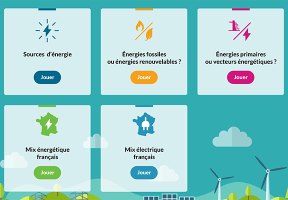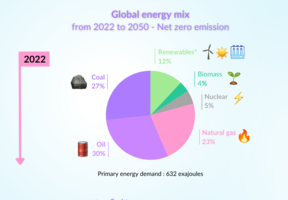Focus on Biofuels
10 min read

Laurent Fourage
The Future of Algae Fuels
The industry is looking beyond conventional approaches to a new generation of fuels based on microalgae . These new fuels could be ready for the commercial market before the end of the next decade. Laurent Fourage, CO2 Bioconversion Program Manager at Total’s & Chemicals business segment, offers his analysis.
Microalgae biomass is the subject of extensive research and tests around the world. It is already used commercially in the production of high-value-added products in the biochemistry, cosmetics and food industries, generally by innovative start-ups that have found their markets.
A Long Chain of Research
The conversion of microalgae biomass into biofuel – or algae fuel, as it is sometimes known – is still in the development phase. Huge volumes must be processed and produced, which raises questions about technology choices and profitability. That is why research is today undertaken by large industrial companies (particularly energy groups), supported by the world of academia.
Identifying the species that will produce the largest quantity of convertible oil is the first challenge. In addition to finding the best natural microalgae strains, researchers may attempt to genetically modify existing strains to improve their yield. However, they face restrictions here because E.U. standards prohibit the cultivation of genetically modified microorganisms (GMMs) in open spaces. “screening” – which consists in reviewing hundreds of thousands of algae species – is therefore the way forward. We are a long way from having explored every option.
The next step is to develop the best cultivation method. Bioreactors (such as the glass tubes that we have all seen) are currently best adapted to the production of high-value-added products in low volumes. For biofuels, the most mature solution today still seems to be open ponds, as they require less investment and best meet the need to produce in large quantities. Prototype facilities (hectare-sized in Europe) have already been installed, alongside laboratory research.
The main objective of current research is to increase the yield per unit area. Researchers face a myriad of technical issues here, but there are solutions for each one. The process of harvesting the algae biomass from its cultivation environment is one of the main operations that requires further work and optimization. Extracting the oil is also a delicate step, as it involves removing an extremely hydrophobic product from a highly hydrophilic environment. Oil and water are not a good mix! Once this has been done, the standard processes for converting vegetable oils (e.g., rapeseed and palm oil) can be used to turn the algae oil into biofuel.
Researchers are also working on a different approach known as hydrothermal , where the oil is not extracted but instead the algae biomass is used directly. After being harvested, the algae is converted under temperature and high pressure into a crude-like bio-oil that can be refined. The advantages here are that non-oil-producing strains can be used and that the biomass is harnessed in full. The process recreates what nature does over millions of years to produce oil.
Advantages and Disadvantages
The use of microalgae has numerous environmental advantages. The strains used can be cultivated in seawater, and therefore have no impact on freshwater supplies. Extensive areas are certainly required to install basins, but there is no need to use arable land. What is also very interesting is that microalgae cultivation requires CO2. Around two metric tons of CO2 are needed to produce one metric ton of biomass, meaning that biomass production represents a potential means of utilizing CO2 and can contribute to the fight to cut emissions.
As in all emerging industries, the main obstacle is cost. Primarily because facilities are limited to pilot scale, the cost of producing algae-based fuel is today estimated at between €5 and €10 per liter, which rules out commercial production.
But the opportunities are real, as evidenced by the huge amount of research being conducted around the world. The United States is particularly active in the field, supported by significant public funding. India has made major progress and China has a vast network of academic labs.
There is also a good academic network in France. Thanks to the commitment of industrial groups (including Total) working in partnership, we should see the launch of an industrial and commercial biofuel project by 2025.
Laurent Fourage is CO2 Bioconversion Program Manager at Total’s Refining & Chemicals business segment. He previously worked for Protéus, an industrial biotechnology specialist. Laurent is a graduate of Nantes University. Before joining Protéus, he completed post-doctoral studies at the MRC Laboratory of Molecular Biology in Cambridge, United Kingdom.

Biofuels, 30 Years of Steady Progress
Fuels made from biomass that can be mixed with fossil-fuel-based gasoline and have improved over the years. Conventional biofuels are now a commercial reality around the world, while advanced biofuels, made from forest and farming waste, are being brought to market and will gradually round out the first generation. Jean-Christophe Viguié, “Biomass to Fuels” Program Manager at IFP-Énergies Nouvelles, gives us an overview of the industry’s progress.
Conventional and Advanced Biofuels
One of the major challenges we face today is how to decarbonize land, sea and air transportation, as this sector alone represents over 20% of global CO2 emissions. To successfully address this issue, we need to implement multiple solutions that work together, including improving engine performance, developing electric and hybrid mobility solutions and using alternative fuels, in particular, biofuels made from biomass.
Biofuels include “conventional” first-generation and “advanced” second-generation fuels. A potential third generation derived from algae is being developed, but is not expected to hit the market until after 2030. Just like for first- and second-generation biofuels, these algae-based solutions will offer a complementary option, not competition. The planet’s climate will only be successfully preserved through a combination of technologies. When it comes to biofuels, there are no generational conflicts.
Conventional biofuels have been a commercial reality for more than 30 years. In 2018, they represented 3.8% of global energy consumption for road transportation. Biofuels are constantly progressing, even though there has been a slowdown since 2010. In Europe, we fill our gas tanks with fuels that contain 7% to 8% of conventional biofuels. In industry and agriculture, the biofuels sector is a non-negligible source of jobs, employing some 25,000 people in France. In other words, there is a lot to be positive about.
Brazil and the United States are by far the largest market players in bioethanol, which can be mixed with gasoline and is derived from the sugar in cane, beet, corn and other crops. The European Union, on the other hand, has a solid manufacturing base for , which can be blended with regular diesel and is derived from oilseed crops such as rapeseed, oil palm and soybean.
Rollout of Advanced Biofuels
In the 2000s, as a result of the much-discussed risk of conflict between biofuel and food crops, research increased all over the world to develop “advanced” biofuels. This generation of fuels is made from straw and wood waste and other residues, and uses technologies that do not require converting agricultural land or clearing primary forests.
Today, these technologies are very sophisticated and most countries have contributed to their development. France has set up two programs: Futurol, a process for producing ethanol, and BioTfueL, which by 2020 will have developed technology for producing synthetic biodiesel and biojet fuel. These advanced biofuels make it possible to reduce greenhouse gas emissions by over 85% in comparison to their fossil fuel equivalents.
Now, the challenge is to roll out these technologies on an industrial scale in France and globally. Competition is stiff all around the world, with projects underway in Eastern Europe, India, China, Brazil and North America, among others. It takes four to five years to set up an industrial-scale project. Europe, and therefore France, needs to do everything in its not to be left behind. The European Directive of December 2018 (RED-II) set the 2030 target of making biofuels account for 14% of total fuel, and advanced biofuels 3.5%. This confirms that the two generations are part of the same solution and are not in opposition. An advanced biofuel production unit can even be integrated into a conventional biofuel plant or an oil refinery, unlocking synergies and reducing the significant investment outlay.
Biofuels in the Aviation Industry
Now we need to encourage and incentivize investment through stable tax and financial rules. Unlike for renewable and , there are no feed-in tariffs for biofuels. A favorable tax regime must therefore be implemented to make up for the production costs, which remain higher than those of fossil fuels. In fact, the success of biojet fuel in the aviation industry will be contingent on a favorable tax environment. This is a pressing issue worldwide. As long as jet fuel is tax exempt, airlines have no convincing reason to buy biojet fuel.
It is essential that airlines switch to biofuels to reduce CO2 emissions from transportation. Emissions reduction is not the only advantage: the biofuels sector is likely to generate local jobs in industry and agriculture. Today, 60% to 70% of the material used in France to produce bioethanol is grown and converted within the country. It follows that the same would be the case for advanced biofuels. In this sector, reindustrialization and the fight against go hand in hand.
Jean-Christophe Viguié is the “Biomass to Fuels” Program Manager at IFP-Énergies Nouvelles, a public research organization working in the fields of energy and transportation.

















